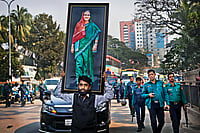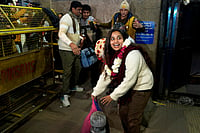In September 2022, when widespread and sustained protests spearheaded by women escalated across Iran, it seemed that the country was tantalizingly close to a change. The trigger was the death of 22-year-old Jina Mahsa Amini. She was arrested in Tehran by the notorious morality police“for violating hijab laws”.
The unfortunate incident brought to the fore decades of simmering frustration of Iranian women who have been forced by the theocratic regime of Ayatollahs to follow the strict hijab rules. Women hit the streets in anger and cries of ‘Zin, Ziyan, Azadi’ (Women-life-freedom) filled the air. These protests are no longer just about the hijab. They have become a political cry for regime change.
Brutal Crackdown on Dissent
Taken by surprise at the vehemence of public anger, Ayatollah Ali Khamenei, the Supreme Leader of Iran, and hard-line President Ebrahim Raisi predictably came down with iron fists on those who dared to question the regime.
The first protests took place after Amini’s funeral in the western city of Saqez when women ripped off their headscarves in solidarity but soon the anger spread across all provinces. Boys and men came out in huge numbers, too. An angry regime swung into action—protesters were beaten, arrested, and tortured in jails across the country.
Four men were executed on vague charges without a fair trial to send a chilling message to those who dared to question the state. According to the US-based Human Rights Activists News Agency (HRANA), at least 522 people were killed during the protests, which included 70 minors and 68 security men. Nearly 20,000 protesters were arrested and around 200 were charged with crimes that carry an execution sentence.
A Period of Relative Calm
Since the beginning of this year, some prisoners have been freed. Though in the minority Sunni and Kurd regions people continue to rail against the government, the number of protests has come down.
What does this pause indicate? Is the government, beset with problems on several fronts, in a mood to relent as the immediate danger appears to be under control? Are the protests fizzling out? Have the strong-arm tactics of the government succeeded or are people biding their time and waiting for an opportune moment to strike back?
“These actions can instil fear and intimidation, resulting in a brief lull in protests. However, history has shown that such measures are rarely long-term successes and that people’s desire for change and justice can be tenacious,” says Sujata Ashwarya, professor at the Centre for West Asian Studies in Delhi’s Jamia Millia Islamia.
Change is visible. Images and videos of women walking around the streets without a hijab are doing the rounds. Though most of these women belong to major cities and not from rural areas, something has certainly changed in Iran.
“Stalemate does not always imply that people have been cowed; it can also indicate that people are no longer afraid, and the government is taking its time in responding to any perceived violation. In either case, the protesters have won the battle of perception,” Ashwarya, who follows Iran closely, says.
With reports of shootings, hangings and rapes, the Iranian government has never looked worse to Iranians or the rest of the world. Though the authorities have blamed the protests on the “West and outside forces”, the regime’s legitimacy has been completely eroded.
Silent Protests Continue
Mass protests may have discontinued, but the Iranian women continue to resist silently—they are walking around without a hijab, girls are wearing shorter manteaus, women are colouring their hair pink and opting for body piercings.
Every public display of affection, each song sung in metros, commenting, subscribing or liking of posts on social media about women’s rights and protests—these silent actions scream to say that women will continue to protest against the status quo. While authorities have managed to curb the mass protests to show to the world that the situation is under control, they will find it difficult to stop these silent protests.
Students Under Scanner
As a large number of students are at the forefront of the protests, Iran’s education ministry decreed last month that those flouting the hijab law won’t get to avail educational facilities in schools and universities and women without a headscarf won’t be allowed in classrooms.
The action is in line with the statement issued by the education ministry which said it aims to “create a positive and constructive discourse among students on the issue of Islamic culture and beliefs, create inner vitality and a correct and positive attitude and beautiful thinking about the culture of chastity and hijab among students.”
What Next On Hijab?
Since the protests, many Iranian women have dropped the hijab as a show of defiance against the government that mandates how women must dress. The Koran from which the clerics draw their power had advised both men and women to dress decently without mentioning that hair or arms or face must be covered. These were later additions by clerics interpreting what a patriarchal society dictated. But now it has become an integral part of Islam, according to the Ayatollahs in Iran, the Taliban in Afghanistan, and until recently, in Saudi Arabia as well as several orthodox Muslim societies around the world.
Last week, a video from Iran showed a man throwing curd on a mother and daughter in the northeastern city of Shandiz for not wearing the hijab. The duo were arrested, and the man detained for “disturbing peace”.
After the incident, President Raisi said: “If some people say they don’t believe [in the hijab] … it’s good to use persuasion … But the important point is that there is a legal requirement … and the hijab is today a legal matter.”

The law was much more relaxed when President Hassan Rouhani was in power. The situation changed when Raisi succeeded him in 2021. The morality police were deployed across major cities to strictly enforce the hijab rules.
Iran’s Chief Justice Gholam-Hossein Mohseni-Eje’I said last month: “Women without the hijab would be prosecuted without mercy. Unveiling is tantamount to enmity of [our] values.” He added that Iran’s enemies abroad are encouraging the violations. The fact that the international press had covered the protests so widely had also given the regime to call it an “international conspiracy” against Iran.
On March 30, the Ministry of Interior praised vigilantes for acting as “promoters of virtue and preventers of vice.” It is likely that the authorities may now strictly enforce the hijab rules. An authoritarian government that has weaponised the hijab as a religious and cultural symbol will not allow any deviation.
The Politics Of Hijab
The hijab has a long political history in Iran. Ironically, at one time, the hijab represented democracy and freedom. On January 8, 1936, the then Shah, Reza Pahlavi, banned the wearing of the hijab. Much like the authorities today, he said women could not attend either school or university wearing the hijab. He regarded the veil as a sign of backwardness and also advised men to take to Western suits instead of traditional clothes.
Teams were deployed to “unveil” women going out wearing the chador or the hijab. This was largely resented by people, especially in rural areas. Many elderly women refused to step out of the house for the fear of being unveiled. Even minority Christians and Jews living in Iran found it difficult to leave home without the veil.
The Shah was stoutly opposed by the religious clerics who saw it as an attack on Islam. When the Shah was forced into exile by the British for his sympathy for the Germans, they placed his son on the throne. The son was equally Westernised and frowned on the hijab. The new Shah’s wife Farah Diba was a celebrated beauty and a fashion icon of her times, admired for her amazing sense of style.
As opposition to the Shah’s regime grew in Iran, many young women in universities opted to wear the hijab to signify their opposition to the Shah. These young women enthusiastically welcomed the Islamic revolution of 1979. In 1983, the new government passed a law making it mandatory for all Iranian women to wear the hijab in public spaces. Non-compliance would result in fines, lashing or in some cases even prison.
What Next in Iran?
To an outsider, Iranian women continue to work as engineers, doctors, teachers and professors while also wearing the hijab. The reality is different. “While the debate over hijab is important, it should go further. There are significant institutional barriers to women’s political participation,” says Ashwarya.
“Women’s candidacies for parliamentary or presidential elections are routinely rejected by an all-male, unelected Guardian Council made up of the clergy. Women hold less than 6% of the seats in Iran’s current parliament,” she adds.
Iranian women are still subjected to institutionalised sexism, which states that a woman’s word in court is worth half that of a man’s.
Women are not allowed to sing, dance, or show their hair or bodies in public, and they can be married off at the age of 13. The fact that the marriage age was raised from nine, and that women now have the right to divorce and take custody of children, has been the result of a long battle fought by Iranian feminists. Women are still barred from becoming full-fledged judges in Iran for fear of increasing their rights and power through their decisions.
Despite the grandstanding by the Iranian regime, things have changed drastically in the country since last year’s protests. The demonstrations may not be very visible on TV channels and social media as they were a few months ago, but a silent rebellion is taking place across all cities.
(This appeared in the print as "An Unfolding Story")



























